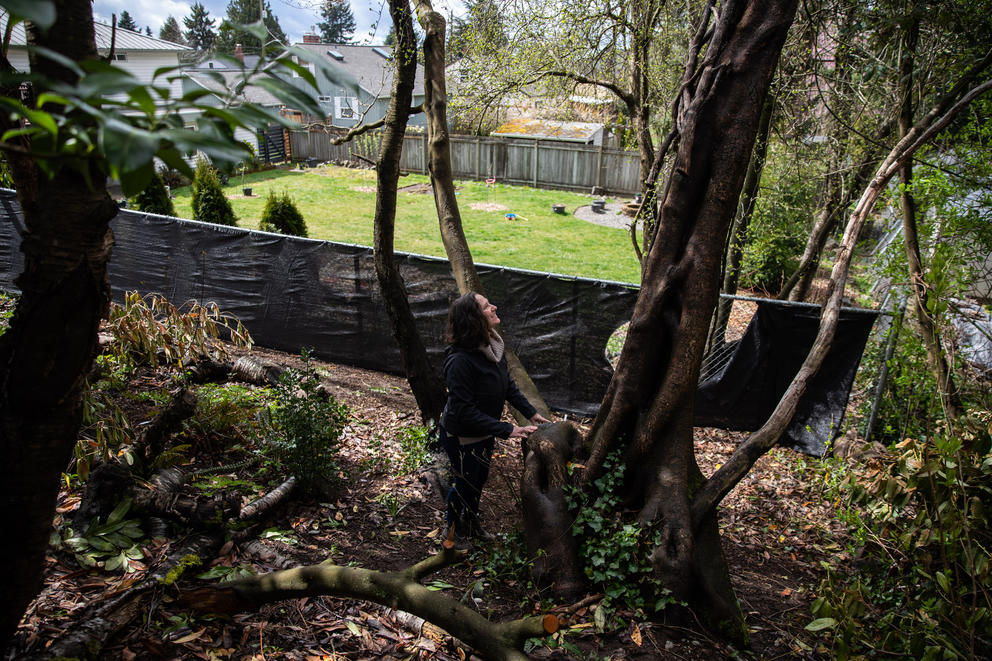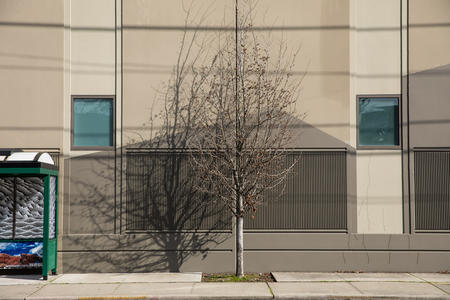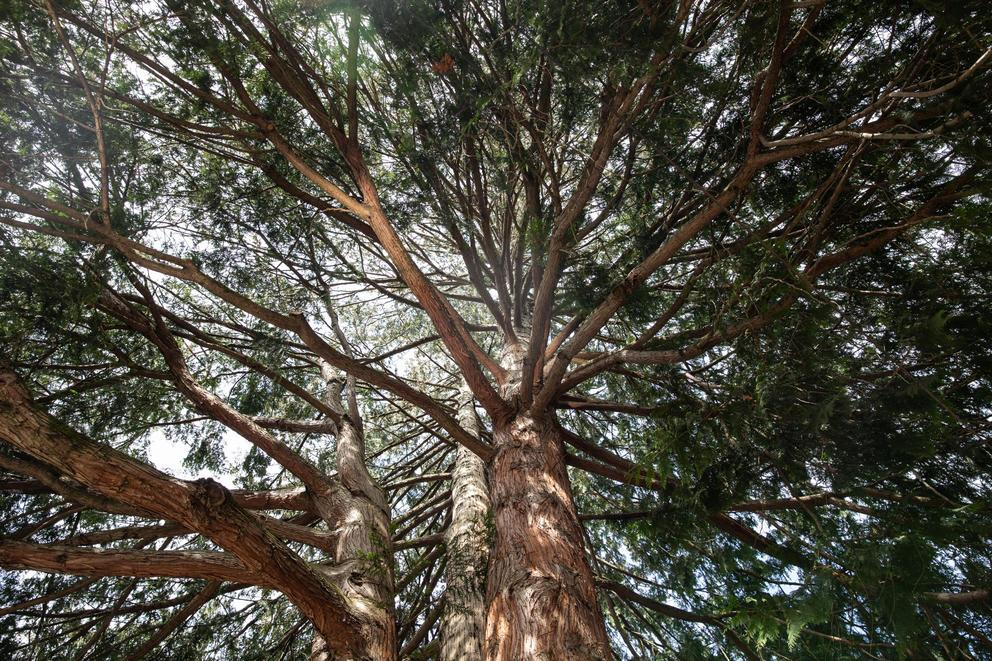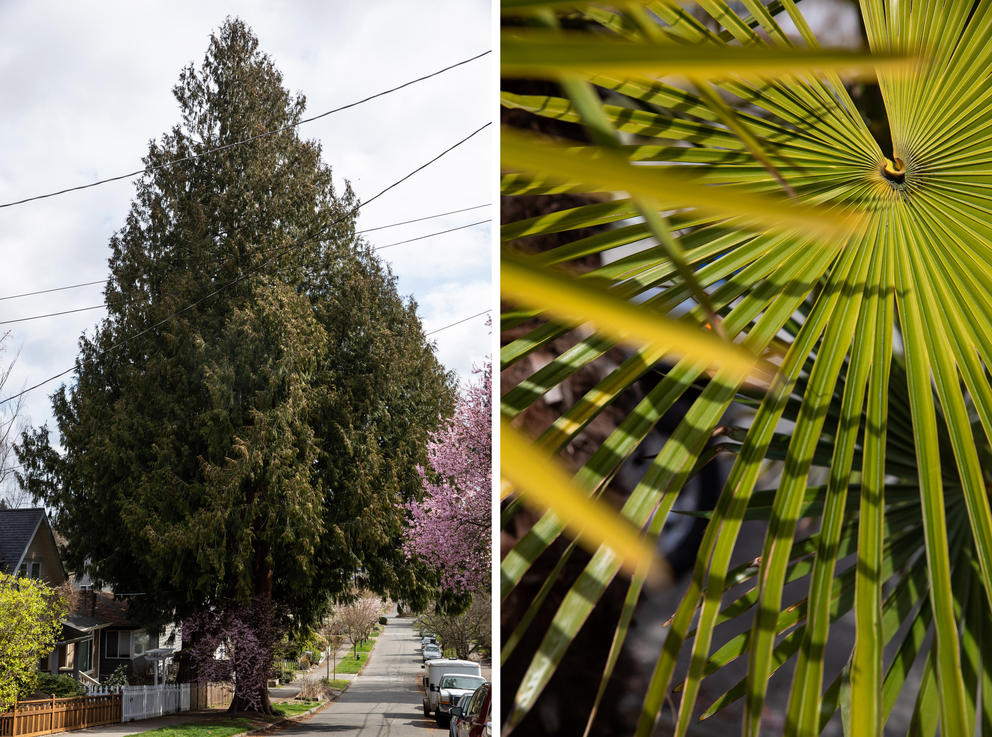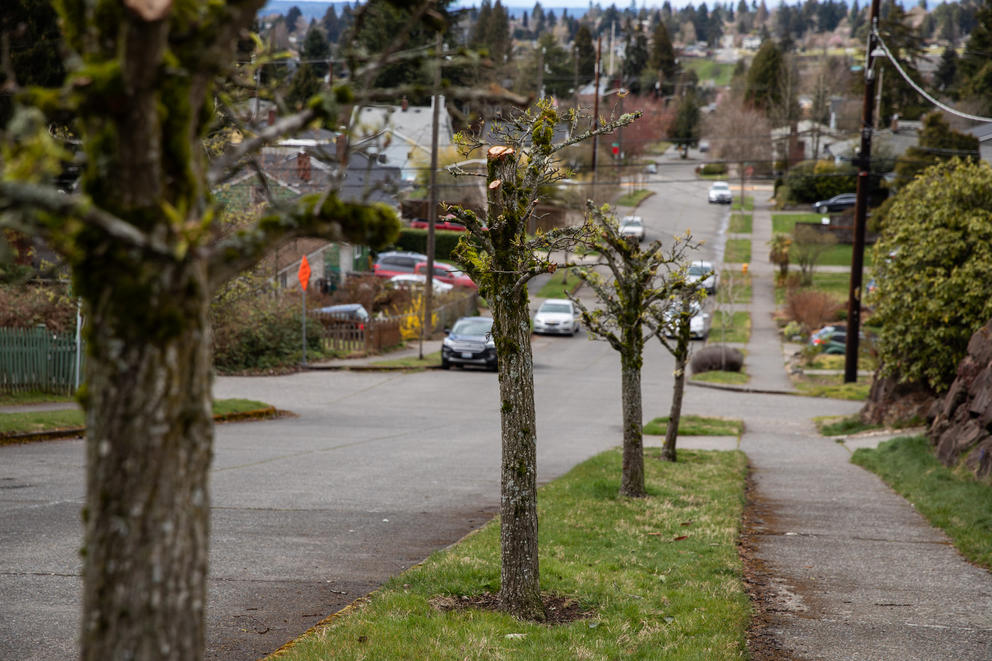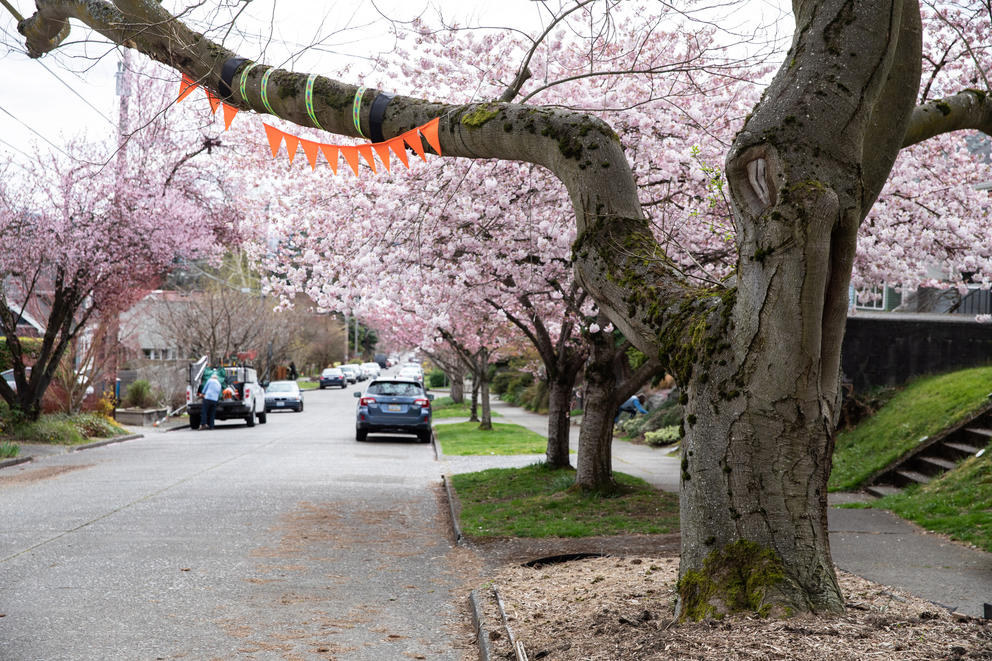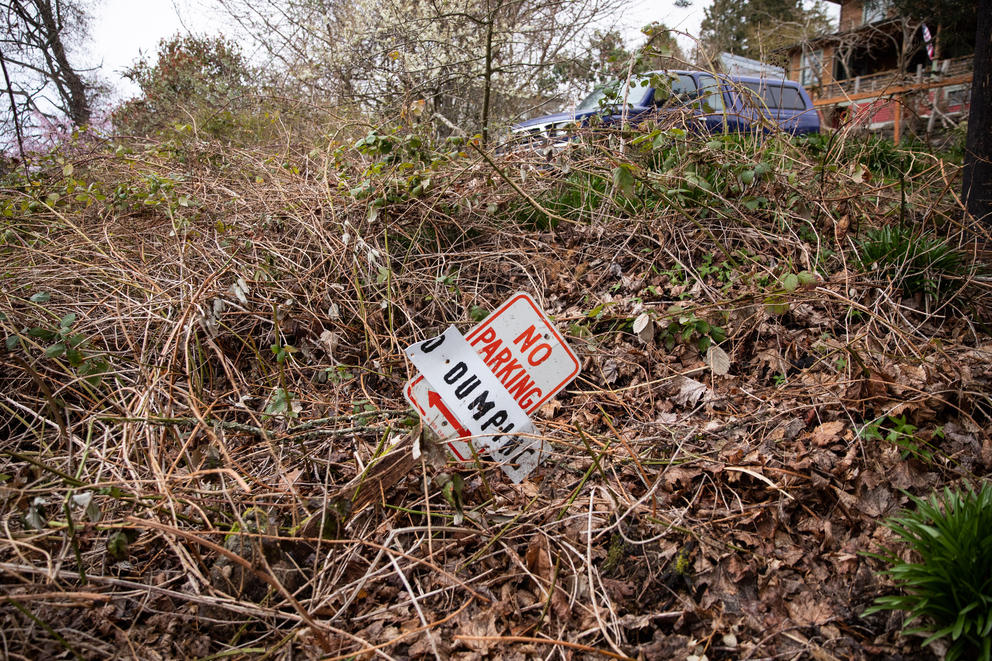Clabots called the Seattle Department of Transportation about the lot right after moving in in August 2018, expecting the city would handle it: The lot was an unimproved right of way, or land designated as a street or path but never paved over. But she was told the trees were her financial and legal responsibility.
“I was like, ‘Well, shit … I guess I’m cleaning it up,” Clabots remembers thinking about the lot at the time. “But I was left in this puzzle of, what are my resources?”
While trees on Seattle streets and in rights of way are technically on public access property, they are almost always the legal responsibility of adjacent property owners. The city’s Department of Transportation regulates the right of way, but it manages only the trees it is documented as having planted, leaving homeowners to figure out the bulk of tree care.
Many homeowners aren’t aware of this obligation, or aren’t ready to provide this care. But failure to support these trees will have an increasingly dire impact on the city’s tree-canopy goals and on the planet.
Trees cover 28.1% of Seattle’s 53,428 acres, with private property owners responsible for the majority of them. About 47% of tree canopy is in single-family neighborhoods. Right of ways, which are publicly accessible, make up about 23% of Seattle’s tree canopy, but private property owners are on the hook to care for most of these trees as well. Altogether, about 80% of street trees are the legal responsibility of nearby homeowners.
In 2007, the city committed to reaching 30% tree canopy coverage by 2037. However, Seattle’s most recent tree-canopy assessment showed the city is losing canopy in both rights of way and neighborhood residential areas more quickly than it’s adding to it. The biggest canopy losses affect historically marginalized communities in already tree-sparse neighborhoods stressed by the heat island effect, a phenomenon where local temperatures rise in the absence of trees and the presence of concrete and asphalt.
With private property owners responsible for maintaining street trees, improving both their awareness of these trees and their capacity to effectively care for them could make or break the city’s forested future.
Clabots, who was dealing with a public space that legally could be paved as a street but hadn’t been, envisioned an urban oasis with thriving trees providing shade and greenspace in a part of Seattle losing tree canopy faster than almost anywhere else. After putting thousands of dollars and hundreds of hours into the lot, Clabots created a refuge for people and wildlife, complete with a branch-lined mulched pathway. She removed seven bitter cherry trees and a holly, and added five each of native cascara and Douglas maple trees, interspersed with native plants like serviceberry and salmonberry. She retained some snags, or dying trees that provide animal homes, but most trees there now are bursting with healthy limbs gently sloping upward instead of into her fence line.
She feels proud of what she’s given her neighborhood in a sloped, unwieldy space that she feels doesn’t conflict with citywide housing-density goals. But she’s also frustrated, living an extreme example of the confusion people feel about street-tree regulations — a confusion that often negatively impacts trees and people’s quality of life.
Street trees live hard lives. Some stressors, like climate change, are out of individual residents’ control. But most are symptoms of a lack of knowledge about how and where to plant; of awareness about who’s responsible and in what ways; and of easily understood, equitable resources to help people take responsibility for street trees. All of these, according to arborists, government employees, researchers and advocates, negatively affect people’s relationships with trees and their neighbors and exacerbate environmental justice concerns.
“It’s really bad for community. It’s not how we’re going to see progress on canopy coverage,” says Clabots, frustrated tree neighbor turned tree advocate.
Reducing confusion about what qualifies as a street tree and how they receive care could help these trees last longer, many people told Crosscut. Proposed new regulations and funding for street tree care offer glimmers of hope for improving human/tree relations. In the meantime, tree lovers both inside and outside of the government would love the public to know more.
The 3,000-square-foot vacant lot between Barbara Clabots' property and the road was overrun with blackberry bushes, a dozen mostly dead trees and vegetation that loomed over her fence. Strangers frequently dumped everything from construction debris to tires into the lot. Clabots called the city about the lot, expecting they would handle it. She was told the trees were her financial and legal responsibility. (Amanda Snyder/Crosscut)
Quiet heroes
Seattleite Sandy Shettler has lost count of all the benefits trees provide. She rattles them off with enthusiasm on a self-guided tour of the sorbuses, cedars, stewartias and other street trees in her neighborhood.
“Trees give people hope. They make people happy,” says the social worker who has become a fixture in local tree advocacy. She eyes branches rich with buds, waking up from winter dormancy with an expectant optimism. “They're a simple answer to a lot of problems.”
In scientific and planning circles, these benefits are known as ecosystem services: Trees clean, shade and beautify our cities. They are often the first things rain encounters when it falls to earth, filtering out pollution before water meets the street. They strengthen soil, provide habitat, and feed people and wildlife. In recent years, research has shown how important trees are to people’s physical and mental health, to the point where even being able to see a tree from a hospital bed can improve patient outcomes. And then there are the intangibles: Trees, towering overhead, create a sense of place, safety and connection to generations past.
No tree directly touches quite as many lives as a street tree. They’re beside us as we walk, roll and drive through town, shading the street and sidewalk and filtering out pollution.
And yet trees along our streets live in terrible conditions: surrounded by car exhaust, bumped by unskilled drivers, interrupted by power lines, subject to construction mishaps and sometimes even knocked over in car crashes. And they are stressed by climate change, which is making their essential cooling work even harder.
Tree advocates have been trying to make people aware of these hazards for a while. “When one considers what the average street tree is up against it is really a wonder that we have any of them left," reads a Seattle Times article from April 5, 1927, when the U.S. had about a quarter of the cars we have now.
We haven’t always had the benefit of these martyrs lining our streets. In the late 1700s, people in the U.S. recoiled at the idea of planting trees along streets, where they were seen as nuisances. But soon, concerns about aesthetics, public health and place-making — and the comforting new development of fire insurance — spurred people to intentionally plant street trees.
Before Henry Yesler set up his lumber mill in the late 1800s, Seattle was Douglas fir from corner to corner, says Nolan Rundquist, the Seattle Department of Transportation’s city arborist for just over 25 years. “But if you look at pictures from the 1920s, they’ve got about six trees in the whole town. It gets crazy,” Rundquist says with purposeful hyperbole.
The Emerald City set about lining roads with trees in the early 20th century as part of beautification efforts. Planting slowed in the 1940s and 1950s, Rundquist says, but tree boosters rooted street trees with new enthusiasm ahead of the World’s Fair, which came to town in 1962, the year after SDOT became responsible for street-tree regulation. King County’s Forward Thrust ballot initiatives in 1968 and 1970 didn’t get the region a rapid transit system, but they did pay for nearly 30,000 trees around the city, mostly on arterials. Since then, small business administration grants, levies and bonds have dotted streets with trees, and SDOT plants trees anytime it reconstructs a street.
It’s no wonder people might assume that all trees in public places are part of city infrastructure, and therefore the city’s responsibility.
Missing the forest …
If you’re a property owner, there are two ways to know if you are responsible for street tree care: Call a city arborist, or reference a little-known online map of documented street trees in Seattle that lists who’s responsible for each individual tree.
SDOT claims management responsibility for 38,565 of the city’s roughly 172,500 documented street trees; the city’s municipal code tasks homeowners with figuring out how to coax life from the rest of them.
Councilmember Dan Strauss represents District 6, a part of town in North Seattle with middling canopy coverage. He also chairs the city council’s Land Use Committee, and says that even city officials struggle with figuring out who’s in charge of planting and caring for trees in rights of way.
But, he says, “If there's a tree in front of your house, you are almost certainly responsible for caring for its maintenance, growth and survival.”
SDOT has been documenting street trees for decades, but the data is incomplete. The age and provenance of anything planted before 1950 is murky, and even details about trees planted more recently — their size, their species, their condition — often come with an asterisk.
“When I go and visit these trees in person, I would say maybe 20% of them are wrong on the species level,” says Taha Ebrahimi, author of an upcoming guide to Seattle’s street trees. Ebrahimi works at data visualization company Tableau. After discovering an interest in local trees during the pandemic, she used a tool she manages to visualize city street-tree data and dig into its gaps.
SDOT teams have been visiting every identified street tree at intervals over the years to confirm they’re still there and see how much they’ve grown, but it takes a long time for the agency to visit them all; some trees haven’t been listed as “verified” since 2008, if ever.
Rundquist has made a point of improving the street-tree inventory, sending interns in recent summers to document new trees. In the process, SDOT has added 50,000 previously undocumented trees to the map, bringing the total to 172,502 street trees as of March 2023. He expects at least 50,000 more are still undocumented.
Over the past few decades, people have started to recognize how many of these trees were planted — or built around — in ways that disadvantage them. As they try to find purchase below power lines and between sidewalks, pipes, gravel beds and streets, trees put up branches and lay down roots where they can, competing with other ways people want to use the right of way. Today’s arborists and residents inherited the urban planning and optimistic planting decisions of their predecessors, and the trees pay the price for those choices. It is unclear how many street trees the city has lost over time.
A towering ash living in a narrow nook of a planting strip in Sandy Shettler’s neighborhood is one of her favorite trees — but it could never get planted today, she says. The city has adopted a “right tree, right place” mentality: approving tree species in places where they have the best chance to thrive without interrupting pavement and power lines.
Many streets, it turns out, are lousy with pavement and power lines.
“If we exclusively follow ‘right tree, right place’ … then we'd have these tiny little trees that provide no canopy,” Ebrahimi says. “We kind of take it for granted that, only in Seattle can you look on a block and see a Douglas fir and a palm tree and a maple.”
Outsourcing tree management
Cities offload maintenance onto residents as a cost-saving measure, says Ben Thompson, urban and community forestry program manager with the Department of Natural Resources. “It’s not like cities are going, ‘Hey, let’s make the private property owners pay for it.’ They just don’t have a lot of other recourse. … There’s a huge maintenance burden among Washington communities that they just can’t catch up to,” he says.
SDOT had a budget of about $6 million for tree trimming, maintenance and planting in 2022, and has spent about $40 million on this work since 2016. Arborists unaffiliated with the agency say the department could really use additional funding for street-tree purposes. Kristin Brown with the Office of Sustainability and Environment says the city is figuring out the funding gap for tree-related programs as part of a City Council legislative request.
SDOT’s tree crew has grown from two to nine people since Rundquist joined the department. Varied staff are ISA certified arborists, Bergerson says, including three members of the tree maintenance crew, 11 office employees and three members of the landscape maintenance staff.
It costs about $330,000 to run a water truck in the summer to water about 2,000 trees, Rundquist says. “We feel we have an obligation to make sure the tree does OK if we put it in. We’re going to be dedicated to at least getting one water bag filled up each week for four summers,” he said.
Homeowners, then, are footing an important bill by doing the same for thousands more trees. But they can’t do just anything with trees in these spaces.
SDOT regulates not only how people care for these trees, but also which species they can plant and how much pruning they can do without needing a permit. The city also prioritizes preserving trees wherever possible, so homeowners can’t remove or intentionally damage trees without facing substantial civil penalties or punitive damages.
Sam Taboada, a foreman with Ravenna Arborists, prunes a tree for a private residence near a sidewalk in Wallingford on Wednesday, March 29, 2023. Collin Wheeler, the owner of Ravenna Arborists, says their work centers around pruning trees for health and beauty, lifting them to code over the street and sidewalk, clearing them from utility lines and restoring their canopy. (Amanda Snyder/Crosscut)
Permits are required for tree planting and removal, as well as for pruning branches larger than two inches in diameter — no wider than a Red Bull can, one arborist quipped. Permits are also required for removing more than 15% of a tree’s total canopy, which can be as little as a few branches on a new tree.
“Basically what we're trying to do is protect the public by making sure that the tree work that goes on out there is beneficial to the trees and doesn't create risk,” Nolan says of the permit system.
“Residents don't often have the authority to make decisions about street trees … and yet they are expected to help maintain the trees,” says social ecologist and street-tree researcher Christine Carmichael. “But there's not a lot of guidance or support.”
Seattleites reportedly removed 8,245 trees by permit between 2007 and September 2019, with 8,601 trees scheduled to replace them, per consultant David Moehring, who submitted this information to the Seattle Urban Forestry Commission.
The state doesn’t have an inventory of how cities manage their street trees — but when it comes to tree maintenance in Washington, DNR’s Thompson says none of the 281 incorporated municipalities he works with is really knocking it out of the park.
Thompson’s program is mandated under state law to encourage tree planting and maintenance in Washington’s cities, and may help them develop ordinances that cover street-tree care — but it doesn’t enforce street tree regulations.
Most Washington cities that defer care to homeowners are not in regular communication with them about their role in tree care, Thompson says, and it’s residents’ job to know what their responsibilities are. “If it’s [outlined] in an ordinance, there’s no outreach or follow-up with residents until there’s an issue,” he says, noting he's seeing more communities starting to get better at communication.
Sometimes residents unwittingly take on that outreach role.
Shettler has seen firsthand how a lack of communication can impact trees. A few years ago, a developer put up townhomes near her home in Wallingford and replaced cleared trees with four new ones in the planting strip. “These are all dead,” she says, staring at the trees with frustration. “They’re just corpses. Sitting there.” She doesn’t think the new owners were keyed into their legal responsibilities to do their best to keep those trees alive.
Shettler has herself started caring for street trees within a three-block radius of her home. Equipped with hundred-foot hoses and a bubbly personality, she’s been taking on watering where she doesn’t see it happening, knocking on doors and asking for help as well as permission to borrow people’s faucets. “But who does all this? I’m weird,” she says on a walk in March, pointing out dozens of trees she knows well and the people she’s met through their trees and through being involved in their care. Most people, once Shettler chats with them, take on the responsibility they didn’t know they had.
“What I’ve found is more common, is that people aren’t informed about their trees, or, more importantly, they're not connected to their trees,” Shettler says. “You really need that emotional connection. And that can be built.”
How to care for street trees
Tree advocates, professionals and residents say Seattle could do a better job of letting people know maintenance is expected of homeowners and landlords, and connecting them with educational resources.
Tree planting and care isn’t as intuitive as many people think, says Lou Stubecki, an arborist with Seattle Public Utilities, one of seven city agencies involved in tree management. Some things, like how deeply a tree is planted or how its roots are situated, can’t easily be corrected later; and people often want to plant in the spring, when fall is better for the trees.
Andrea Starbird, a certified arborist with Seattle Tree Care, speaks highly of city arborists and says the agency has some great online educational materials, but you have to know what you’re looking for to find them.
And trees need more active management than they did historically. “They used to grow so easily, that we're like, ‘Oh, if you don't like it here, just chop it down, plant another one and in 10 years, you'll have shade — not a big deal.’ But we can't do that anymore,” Shettler says.
Where only younger trees used to need regular summer watering, even middle-aged and mature trees are thirsty now, says Starbird.
Trees ultimately need a mixture of watering, mulching and pruning — and, to keep the peace with other street uses, raking. How and when these activities need to happen depends on the tree’s species, age and location. They’re lower-maintenance than house plants — but street-tree care is a responsibility people sometimes just can’t stomach.
Anyone — with or without street-tree responsibility — can use helpful city resources, including an online species selector and an email listserv with tree-care reminders.
“I like trees — just not this one”
City arborists spend a lot of time persuading homeowners to coexist with trees.
But residents often try to remove or heavily prune trees — with or without a permit — to preserve their views or reduce liability. City arborists generally won’t approve tree removal unless they determine the tree is high-risk or dying. A 2017 SDOT report found that trees were likely responsible for 12% of sidewalk uplifts — a critical problem when people of all abilities need to be able to pass sidewalks safely — and prompted 80% of sidewalk-related complaints.
A substantial tree canopy is harder to replace than a sidewalk.
“If we can get another 15, 20 years out of that tree — the tree might be worth $40,000 and the sidewalk costs $1,500 to repair — it’s cost-effective to keep the tree,” Rundquist says.
Sometimes residents don’t want SDOT to plant trees, Rundquist says, because even though SDOT is responsible for watering, pruning and mulching what it plants, the homeowners would end up raking the leaves.
Lacking knowledge, homeowners inadvertently create problems for themselves by pruning poorly, or assuming pruning is the city’s job.
“Sometimes people just see it as too much work,” Rundquist says.
Most bad pruning likely isn’t malicious, but people do cut corners. Asked for penalty data, Bergerson replied, “The large majority of ‘bad pruning’ violations are resolved through our permit system, and most of those incidents involve smaller trees that have been improperly pruned by a property owner.”
It might seem like a resource-savvy decision to cede maintenance to property owners, but often, DNR’s Thompson says, the money saved on maintenance is taken up by handling penalties.
SDOT tries to be reasonable and sane about enforcement, Rundquist says. “We don’t want the people dealing with trees to be looked upon as just a bunch of bureaucratic thugs. We want to help people.”
But in some cases where residents haven’t been on board with new trees, Rundquist says, “they just drove over them with their pickup truck.”
Whether such people are bad actors who get taken to task depends on what people nearby have to say about them, because enforcement is complaint-based, according to Josh Morris of the Urban Forestry Commission.
And that can lead to neighborhood tension.
Clabots in West Seattle says she tries not to get involved in tree disputes, but a few weeks after the June 2021 heat dome she noticed someone in an unmarked van pull up to a street tree and start chopping it down without safety gear. She was feeling traumatized by seeing neighbors suffer through the heat dome without air conditioning, and seeing trees hacked away was too much. “I’m, like, postpartum a couple months, and it’s the pandemic,” she says, laughing through a grimace, “and I come out there like, ‘Excuse me, let me show you on the map that this is a right of way tree and you need a permit to cut this down.’” But they ignored her. She called SDOT’s Trees Hotline to report the removal. “And [the person on the other end] goes, ‘It’s their tree, it’s none of your business,’ and I was like, ‘That’s not true.’ But she hung up on me.”
It was awkward to have that conversation with someone she’d been friendly with, she says. “It’s not really fair because he had no clue, and then he and I are put in a really uncomfortable situation and that’s not really good for neighborly relations.”
Closing the street-tree equity gap
The costs associated with caring for street trees create equity problems in parts of town already suffering from a low tree canopy.
The Trees for Seattle Parks program estimates it costs $4,000 to plant and support a tree through its first five years, mostly due to watering. It can take 10 years for a tree to provide all of its ecological services — meaning care providers are often taking a decade-long risk by planting. Trees also cost more as they age and need to be majorly pruned or removed, and removal can cost thousands of dollars by itself.
“If you don’t have the means, it’s difficult to feel like you’d want to take on the potential burden of a street tree,” Morris says. One of his colleagues recently found themselves liable for about $5,000 to help the city fix concrete when a tree in their South Seattle neighborhood heaved up through a sidewalk. It took years of conversations with lawyers to clarify their financial responsibility, but they were luckily able to go through their home owners association to cover costs.
“It’s a huge challenge and something I think we’re going to have to address eventually,” Morris says. “If you’re an individual homeowner, you might have to fix it, but you’re not going to plant another one if it doesn’t seem like a smart investment.”
City employees are trying to make planting street trees easier in neighborhoods facing economic and racial injustice.
Two of them, arborists Jana Dilley and Lou Stubecki, met recently in Rainier Beach on a quiet street lined with parked cars and small, delicate Japanese snowbells and Chinese fringe trees. The family who planted these trees, each no more than a few inches in diameter, received them as part of Trees for Neighborhoods, a Seattle Public Utilities program that Dilley started in 2009 and which Stubecki manages.
Trees for Neighborhoods gives free trees to residents, targeting its outreach toward historically underserved neighborhoods like Rainier Beach. Staff guide program participants in selecting the biggest space-appropriate tree that is hardy, pest-resistant and climate-resilient, then train them how to site, plant and care for trees in yards and nearby rights of way. Trees for Neighborhoods contracts with South Seattle-based Dirt Corps and the University of Washington Botanic Gardens to deliver the program and expand outreach.
“We never force people into the program, but we try to let people know about it and why they might want to participate,” Dilley says. “We don’t just passively sit by and wait for people to come to us.”
Families receive a watering bag and mulch and take free planting and pruning classes. Stubecki checks on each program street tree annually for two years and offers homeowners advice.
The program’s two-year survival rate, including both yard and street trees, is about 96%, and its 10-year survival rate is about 90%. About a quarter of the 13,400 trees given out since 2009 have gone into rights of way.
More people are becoming passionate about getting trees in the ground near where they live. Dilley says demand matches the program’s capacity, but Stubecki feels that there’s twice as much demand as the three-arborist program can support.
“People do go away unsatisfied,” Stubecki says.
Renters can also plant and care for street trees, but they need their landlord’s permission. And they have to be careful about unintended consequences. “We’ve also had people have issues with wanting to plant trees and their neighbor says, ‘Don’t you dare, that’s my view,’” Stubecki says.
People speak highly of Trees for Neighborhoods — but despite its progress, the three-person Neighborhoods team can’t address street-tree canopy inequity at scale with its current resources, they say.
“In terms of equity and management of publicly owned trees and the right of way, I think Seattle has a long way to go. And I wish that wasn't how I felt,” says Seattle Tree Care’s Starbird.
The city tries to curb resident costs by making street-tree permits free and sending an SDOT arborist to review a treatment plan with you. But the permit process can be confusing to navigate.
If Seattle wants to involve more people in street-tree care in under-resourced parts of the city, it or partner organizations could make costlier projects like tree removal even easier to access, Dilley says. It would also require connecting with people in ways that are easy and culturally appropriate, says social ecologist Carmichael, who has researched why residents reject free trees in other cities. And it means centering their needs.
“If you're planting trees, and that's a long-term thing that's going to be in someone's neighborhood or yard, they really should have a lot of say in how that goes,” Carmichael says.
Equitable resources and more collaboration with residents builds trust, Dilley says. “The physical issue is the dead tree that's in the way, but the trust issue … that is what’s at the heart of it. … We need to work in partnership with people, and let communities lead and be there for them.”
The city has been engaging with tree-focused community groups that know their neighborhoods well. Trees for Neighborhoods, for example, does outreach with groups like Dirt Corps, a community partnership program which works mostly in South Park and equips people with the job skills needed for ecological restoration and maintenance.
There is a lot of fear among some communities impacted by racial and economic injustice that tree-planting precedes gentrification, says environmental consultant Sean Watts. “If we're going to address that inequity without really, really close attention to the impact on property values and all of those other displacement pressures, then we're just going to be creating one-class cities,” he says.
A tree with caution tape over a low branch in Wallingford on Wednesday, March 29, 2023. Trees along the streets live in terrible conditions: surrounded by car exhaust, bumped by unskilled vehicle parkers, subject to construction mishaps and sometimes even knocked over in car crashes. (Amanda Snyder/Crosscut)
Bridging the resource gap
New and upcoming government initiatives may address some funding and care concerns.
In March, Seattle Mayor Bruce Harrell issued an executive order requesting the city to develop more funding strategies, including public/private partnerships, to increase street-tree planting and care.
The executive order precedes the publication of Seattle’s next tree ordinance. While the ordinance deals with code sections regulating how trees are managed on private property, proposed new language suggests more assistance may be coming from the city to help plant and maintain new street trees.
“I think [the new ordinance] is going to make it easier for people to care for street trees, because the rules are more clear,” Councilmember Strauss says. “This legislation helps homeowners know who to hire [for tree care], and it also requires — at least for new builds — that those homeowners are provided with information on how to care for their trees.”
The draft ordinance also requires residential developers to replace trees removed during new construction with street trees. If there’s no space nearby, developers would pay into a tree fund targeting street-tree planting “in low canopy areas including BIPOC neighborhoods.” The legislation expands tree regulation to include trees on private property that are much thinner than what’s currently regulated, increasing the likelihood that removed trees will need to be replanted.
According to a fiscal note, the city would expect to plant at least 3,000 street trees over 20 years through this rule, each to be watered and pruned by the city for five years.
But the draft ordinance doesn’t modify language dealing with the section of city code governing street trees regulated by SDOT, and doesn’t include maintenance assistance for current street trees. And for newer, smaller street trees to be planted, existing trees may need to be removed.
With goals of increasing coverage equitably around the city, planting new street trees is part of the math — but it’s not always necessarily the answer in every part of town. “It's keeping ones that are already there,” says Rundquist.
It takes a village
Often, resources come from people’s own communities.
While SDOT arborist Jim LeBlanc provided Clabots with a helpful initial field inspection and some information to get her started, she ran up against hurdles when she tried to use city resources in the process of improving her right of way. Volunteer programs like city-led Tree Ambassadors weren’t able to help her organize work parties, and she had to look elsewhere for extra hands. What got her through were gumption, neighborly support, arborists and volunteer groups.
After a few months of hacking away at blackberries herself, she realized she needed some real help to complete the cleanup. Carmen Martinez, who leads the youth corps associated with the Duwamish River Community Coalition, came to Clabots’ rescue beginning in January 2019.
Duwamish Valley Youth Corps coordinates dozens of young people to help with tree-care tasks. Martinez began giving Clabots advice and tools and helped her organize work parties to clear the lot. Dirt Corps’ Roseann Barnhill helped Clabots design a permit-able tree removal and replacement plan. After getting ghosted by one arborist, Clabots found Allen Taylor with Conservation Tree Care, who helped her finish the job.
She registered with the Adopt a Street program during the summer of 2019 to save on dump fees. That same summer, Martinez supported Clabots in successfully pursuing a Small Sparks grant through the Department of Neighborhoods, funding meant to bolster community-driven neighborhood improvement efforts.
Clabots posted for volunteer assistance on her neighborhood Facebook group, fundraised $800 mostly from family via GoFundMe, and even posted flyers at the Highland Park Improvement Club. While at HPIC, she heard that community member Craig Rankin had revitalized a nearby overgrown right of way with native trees and plants, and felt motivated to keep reaching out to others.
It took years for her to navigate the permitting, design and plan execution — and the trees on the lot next door are still her responsibility. “The costs on a site this big really add up,” she says.
Her story is an extreme case, with the additional burden of simply cleaning up a space to ready it for trees. But as more trees suffer from heat, drought and pests, more people will be on the line to figure out how to navigate and pay for street-tree care.
“I’m really optimistic that there are ways to manage all of these things. It’s just about funding, proper care, proper planning and getting input from people who are being impacted,” Starbird says.
“I think it is really an opportunity for hyperlocal stewardship,” says Clabots. She’s been reflecting a lot on the emotions trees arouse in people — perhaps the entitlement to do with land as we please when we become homeowners, she says — and how addressing those emotions is key to helping trees. “There’s a lot of pride and activism in this neighborhood that I think has not been capitalized appropriately.”
A block from Clabots’ house, one neighbor is following in her footsteps. Roger Kelley, who moved to the neighborhood in 2021, is also responsible for an overgrown right of way. Clabots just found out he wants to improve it, and, like her, has struggled to figure out how.
“This is the worst-case scenario,” Roger says, looking at his right of way. He’s been hacking away at invasive plants for a few weeks. “It doesn’t look like a dump!” Clabots says, optimistically. “We don’t know yet,” Roger sighs. “In the back part of our property, we found hunks of cement, chunks of metal, a vodka bottle.”
But like Clabots, he sees potential for both people and trees. And now he has Clabots, and all of her research, to rely on.
“I haven’t really met many neighbors because they can’t see me, I can’t see them [over the shrubs],” Kelley says. “But I like activity going on here. Like, let's wake up this little corner of the neighborhood a little bit.”
Roger Kelley near the overgrown lot near his home. Kelley, a neighbor of Barbara Clabots, moved into his home in 2021 and is also responsible for an overgrown right of way. Kelley has been “hacking away at blackberries, butterfly bushes, English ivy, you name it,” Kelley said. (Amanda Snyder/Crosscut)
A person walks near a tree overgrowing into the street in Phinney Ridge on Thursday, March 30, 2023. With the majority of Seattle’s trees already on private property, homeowners’ awareness of street trees and ability to provide care could make or break the city’s forested future. (Amanda Snyder/Crosscut)
Listen to reporter Hannah Weinberger discuss this story on the Crosscut Reports podcast:
Get more Crosscut in your inbox
Sign up for our Daily newsletter for the most important headlines of the day or sign up for our Weekly newsletter for the best stories of the week. Or, select both for more Crosscut.



